The Health Benefits Of Sweetcorn
Sweetcorn is a sweet vegetable that can be eaten throughout the day as a snack or as part of a main meal and Lose Baby Weight plans,and it can even be baked into cakes or biscuits for a savoury twist on your favourite sweet treats.
Some people shun sweetcorn as it is known for being a bit of a starchy vegetable that contains carbs, but it is packed with antioxidants, vitamins and minerals as well as plenty of flavour and it is only the processed types of carbs that should be avoided.
Health Benefits
The main health giving property of sweetcorn is ferulic acid, which is an antioxidant found in the cell walls and insoluble parts of sweetcorn.
Sweetcorn contains more ferulic acid than any other fruit or vegetable, and with recent research showing that ferulic acid can ward off disease, cancer, diabetes, heart disease and neurodegenerative diseases such as Alzheimer’s disease, sweetcorn is fast becoming a bit of a wonder food.
Research has also shown that if you cook your corn, the longer you cook it, the more ferulic acid there is in the corn and therefore the higher the antioxidant content.
Sweetcorn also contains vitamin A and C, which are antioxidants that help to protect cells against the effects of potentially damaging free radicals. Free radicals could play a role in the development of cancer, cardiovascular disease and age-related diseases, and so eating foods that contain vitamins A and C is an excellent way to protect yourself against illness.
Sweetcorn is also packed with B vitamins which are known to be very useful in promoting growth and development. B vitamins also help to control how your food is metabolised and the various chemical reactions within your body. Thiamin and folate are also nutrients found in sweetcorn, which are essential for pregnant women – and for everyone!
Sweetcorn also provides lots and lots of minerals, including manganese, phosphorus, potassium, iron, calcium, sodium, zinc, copper and selenium – shall we go on!
Some people worry about sweetcorn because it is sweet – and therefore because it contains some natural sugars. However, these sugars are all natural and because they come with plenty of vitamins and minerals, you can feel safe in the knowledge that a portion of sweetcorn is much better for you than a chocolate bar!
Whilst corn syrup and corn flour are processed, fresh corn is completely natural and unprocessed, making it a great choice for all the family.
Sweetcorn and weight loss
Another benefit of sweetcorn is that it is actually fairly low in calories – 132 calories for a 1 cup serving. This low calorie count means that you can easily add sweetcorn to various meals without going off your diet. Sweetcorn is also full of protein and fibre, which will keep you full, meaning that a side of sweetcorn instead of a side of mashed potatoes or rice will fill you up just as much, for much less calories and fat.
Sweetcorn is usually cooked with butter as this adds to the sweetness of it and helps to make it a little more flavourful, but there are some other ways to cook sweetcorn or corn on the cob without adding fat. Try grilling your corn on the cob – simply spray with cooking spray and season with black pepper and a little bit of salt, wrap in foil and grill on a hot BBQ until slightly charred.
You can also toss sweetcorn or fresh corn from the cob with lime juice, a little freshly chopped chilli and a good pinch of salt for a sweet, sour, hot and salty flavour combination perfect for serving with grilled meats or fish.
You could also simply mix sweetcorn with some diced tomato, red onion, a little oil and lemon juice and some fresh herbs for a speedy salsa.
And don’t forget to check out our current promotions and discounts page to see what specials we have on this week on our Healthy Mummy product range
Sweet corn nutrition facts
Sweet corn is a particular maize species which differ genetically from the field maize. Its kernels are tender, delicious and eaten as a vegetable in many cuisines worldwide. In contrast to the traditional field corn, sweet corn crops are harvested while their corn-ears have just attained the milky stage. The cob either used immediately or frozen for later use since its sugar content turns quickly into starch.
Corn is native to the Central Americas which then introduced to the rest of the world through Spanish explorers. Sweetcorn differs genetically from the field maize by mutation at the sugary (su) locus.
The crop has achieved a major success as one of the important commercial cash crops in many tropical and semi-tropical countries, incuding the USA. Scientific name: Zea mays var. saccharata.

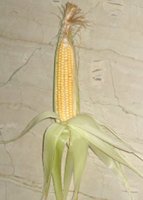
Sweet corn.
Corncob with peeled husk revealing rows of kernels. Note for brown color silk at the tip end.
Corn grows to about 7-10 feet in height. It grows quickly under sunny, fertile, and well-drained soil supplanted with good moisture conditions. Each plant bears about 2-6, long husked "ears" filled with rows of tooth-like seeds arranged around a central woody core (cob). Optimum pollination is essential for full kernel development.
Several different sweet corn cultivars with variations in their sweetness, color, and maturation are grown keeping in mind of local and regional demands. Most farmers opt for crops that attribute superior eating and keeping quality and high yields. Examples include Standard (su), Sugary Extender (se), Supersweet (sh2), Synergistic (sy), and Augmented Supersweet. Depending on the cultivar type, the crop can be ready for harvesting in 65-90 days. Harvesting is done when the free end (silk end) of the ear is full, its silk has turned brown, and its kernels are firm but in the milky stage. Often, farmers check the kernels by pricking them with their thumbnail to ascertain harvest timing.
Baby corns are very young, miniature ears harvested when their kernels are still at the incipient stage. Its central core is sweet and tender enough to be eaten raw. Baby corns measure about 3-5 inches in length and weigh about 20-50 g each.
Health benefits of sweet corn
-
At 86 calories per 100 g, sugar corn kernels are moderately high in calories in comparison to other vegetables. However, fresh sweet corn has much fewer calories than that of in the field corn and other cereal grains like wheat, rice, etc. Their calorie chiefly comes from simpler carbohydrates like glucose, sucrose than complex sugars like amylose and amylopectin, which is a case in the cereals.
-
Sweet corn is a gluten-free cereal and may be used safely in celiac disease individuals much like rice, quinoa, etc.
-
Sugar corn features high-quality phytonutrition profile comprising of dietary fiber, vitamins, and antioxidants in addition to minerals in modest proportions. It is one of the finest sources of dietary fibers, 100 g kernels carry 2 g or 5% of daily requirement of dietary fiber. Together with slow digesting complex carbohydrates, dietary fiber in the food helps regulate in a gradual increase in blood sugar levels. However, corn, in line with rice, potato, etc., is one of high glycemic index food items, limiting its authority as the chief food ingredient in diabetes patients.
-
Yellow variety corn has significantly higher levels of phenolic flavonoid pigment antioxidants such as ß-carotenes, and lutein, xanthins and cryptoxanthinpigments along with vitamin-A. 100 g fresh kernels provide 187 IU or 6% of daily requirement of vitamin-A. Altogether; these compounds are required for maintaining healthy mucosa, skin, and vision. Consumption of natural foods rich in flavonoids helps protect from lung and oral cavity cancers.
-
Corn is a good source of the phenolic flavonoid antioxidant, ferulic acid. Several research studies suggest that ferulic acid plays a vital role in preventing cancers, aging, and inflammation in humans.
-
It also contains good levels of some of the valuable B-complex group of vitamins such as thiamin, niacin, pantothenic acid, folates, riboflavin, and pyridoxine. Many of these vitamins function as co-factors to enzymes during substrate metabolism.
-
Further, it contains healthy amounts of some essential minerals like zinc, magnesium, copper, iron, and manganese.
Selection and storage
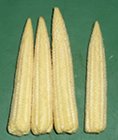
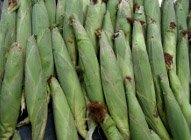
Babycorns cobs.
Sweetcorn cobs in a market.
Sweet corn is a summer season crop in the temperate regions. However, it can be cultivated around the seasons in the tropical belt. In the US markets, fresh corn ears appear on the shelves by May and last until September. Fresh cobs in the form of vacuum packs or processed canned kernels may also be sold frozen in the markets all around the year. The cob generally available as yellow, white, or bicolor seed types. One may also buy them from neighborhood retailers, or for even more enthusiasts, may collect from the "pick-your-own" farms from the local farmers.
Fresh baby corns usually come in small packages wrapped in a plastic paper. Try to buy medium sized, firm, and fresh arrivals.
While buying, look for well-formed ears with light green color tight husks and clean, golden-brown silks. Gently pull down the husk from the tip-end to check for color as well as the stage of kernels underneath. You may buy fresh-husked cobs wrapped in plastic paper. Look for the harvest date; buy only if they are fresh as the kernels soon turn sugars to starch and lose their sweet, juicy flavor. Avoid if the husk is dry as it indicates the old stock and hence out of flavor. Do not buy overly matured cob either.
Once at home, use them as early as possible. If you have to store, keep them in the refrigerator, preferably along with its husk, to maintain flavor, taste, and moisture. They stay well for up to two to three days if stored at 90 percent humidity 32 °F.
Preparation and serving methods
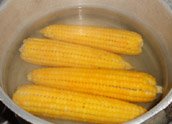
Boiled corn cobs.
Organic produce would not necessitate washing. Just remove the husk and silk and use as a vegetable. However, you may wash the husked cob in cold running water or dip them in salt water for about 15-20 minutes. Mop them dry using a paper towel.
Sweet corn kernels can be used much like a vegetable rather than as a cereal grain. In general, its whole or section of the cob may be served as a main dish. If you desire so to use only kernels in the cooking, then slice through the kernel base all along the central woody core to separate seeds from the cob using a paring knife.
Here are some serving tips:
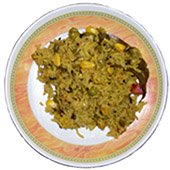
Fried rice. Note for bay leaf, sweet corn kernels, french beans and mustard seeds.
-
Farm fresh, milky-stage sweet corn can be enjoyed as it is without boiled or steamed.
-
The whole corncob may be grilled and served with salt, lemon, and pepper seasoning.
-
The whole cob may be steamed, or boiled in salt water and served with butter or oil.
-
Boiled kernels are an excellent accompaniment to salads, pizza, pasta, risotto, stews, omelets, fried rice, rice pilaf, etc.
-
Sweet corn soup and chowder are favorite starters in almost all corners of the world.
-
Do not discard the water after boiling the cob. It can be used along with onion, carrots, parsnip, celery-stalks, etc., in the preparation of delicious vegetable stock.
Safety profile
Allergic reactions to sweet corns are rare. It is free of gluten and can be a safe food alternative in celiac disease patients. Persons with high blood sugar levels, however, should limit sweet corn consumption in their diet since it carries lots of simple sugars. (Medical disclaimer).


0 comments: